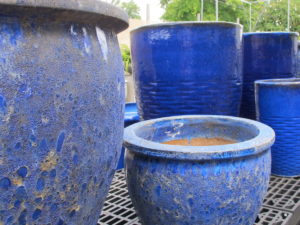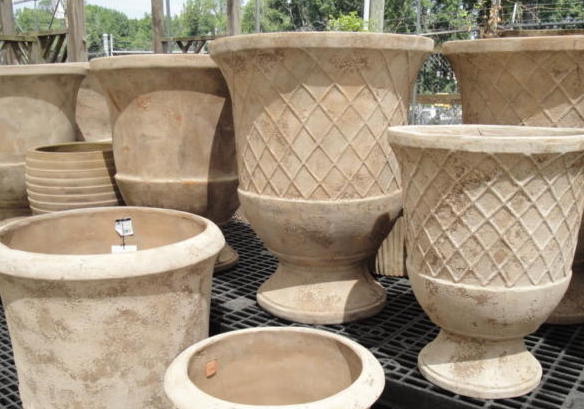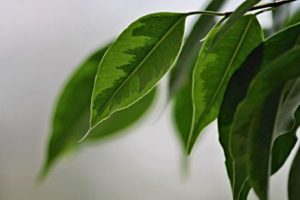Page 2
But If You Want a Nicer Pot
Visit any well-stocked garden center and you’ll see a vast collection of terra cotta and ceramic pottery in every color, shape, and finish. While it is tempting to transplant your fig into one of these beauties, consider whether this is practical.
Unfortunately, these large, beautiful pots hardly ever come with matching saucers. A terra cotta pot can bleed moisture through the pot, even one without a drainage hole, so place a non-porous glazed or plastic saucer underneath.
It is never recommended to plant directly into a larger pot that has no drainage hole. It’s difficult to determine how damp the soil is deep in the pot, and there’s no air circulation in the medium. How the soil feels at the surface does not reflect the moisture level at the bottom. As water pools there, it turns into an anaerobic bog.
 If your fig spends the summer outdoors on the patio, you’re going to have to move it at least twice each year. A large plant in a large pot can weigh a hundred pounds! But if that’s what you want to do, remember that a large soil volume dries slowly. The plant will need ideal growing conditions and very well-drained soil.
If your fig spends the summer outdoors on the patio, you’re going to have to move it at least twice each year. A large plant in a large pot can weigh a hundred pounds! But if that’s what you want to do, remember that a large soil volume dries slowly. The plant will need ideal growing conditions and very well-drained soil.
Something else to consider when planting directly into a ceramic pot is to use one with a wide top opening. Pots with shoulders that curve inward near the rim (lighter blue pots in photo, right) will be impossible to unpot without cutting the root system or breaking the pot.
Double-Potting
Instead of planting directly into that perfect pot, see if you can place the nursery pot inside the pretty one. This is how you can use a ceramic pot without a drainage hole. Check several minutes after watering, though, to make sure water is not collecting in the bottom.
In a decorative pot with a drainage hole, see if a sturdy saucer will fit inside the ceramic pot, under the nursery pot. If it won’t work due to the pot’s curvature, try placing a few layers of 6-mil plastic sheeting under the nursery pot. The sheets should be large enough to come at least partway up the pot. (This plastic is available in the paint department at the hardware store.) Check the bottom of the nursery pot to make sure there are no sharp points that could pierce the plastic.
It might be easier to place the nursery pot on top of a few layers of the plastic film, on the floor. Then, gently lower pot and plastic, as a unit, into the ceramic pot. Keeping some of that plastic film under the rigid saucer, if it does fit, would provide a little more protection for your wood floors.

As long as the plastic film is not torn by turning the pot or otherwise disrupting it, the pot will not leak. You’ll have to be careful about watering, though, making sure that the water is not collecting in the plastic under the pot. Replace the plastic as it becomes necessary, but, with shade and gentle handling, it will last 2 or 3 years.
Now you can more easily move the plant and the heavy pot separately, if you choose to keep them together outdoors. Skip the plastic and the saucer outdoors, though, so water can drain freely after every rain storm.
The Finishing Touches
With a larger pot outdoors, you could dress up the fig with other foliage (Caladium, houseplants, asparagus fern) or flowering plants (New Guinea impatiens, begonia). Simply place pots on top of the fig’s root ball. They will try to root into the soil below. Lift or turn the smaller pots every now and then to prevent this, or let them root in if they’re not that vigorous.
Placing foliage plants on top of the root ball of the ficus is another way to add some humidity—and more plants—to your indoor garden. Ferns, pothos, bromeliads, dwarf peace lilies, and orchids are a few suggestions.
Or, simply add pine bark nuggets or Spanish moss for an attractive finish for indoor plants. Pine bark can be used outdoors as well.
Pruning the Fiddle-Leaf Fig
Fiddle-leaf figs can be purchased as straight-stemmed specimens (photo, top of Page 1) called standards. They have bare stems part of the way up the trunk. Prune or rub off new growth emerging from the bare stem as it appears.
And you can find the bush type, which has 2 or 3 stems in a pot and foliage down to the soil. Dwarf cultivars are sometimes available, with leaves half as large as the species.
The fiddle-leaf fig tree can grow to the ceiling, if you let it. But lack of light at that height and the resulting awkward manner of growth will detract from its appearance. It’s time to cut back the stems, allowing the plant to grow new foliage at a lower height.
How To Prune
Look for the dormant bud on the stem, which you can see above the base of each leaf’s petiole.
Cut the tall stem about 2/3″ above a bud that points away from the center of the plant. This out-facing bud will develop into a new branch that will grow outward, instead of crossing back into the center of the plant. Many kinds of shrubby houseplants and garden trees can be pruned this way.
Usually, the first bud to grow is the out-facing bud. But, sometimes more buds will grow, heading toward the plant’s center. You can decide which will stay, based on the desired branching structure. If growth becomes very congested in the center, though, air circulation and light will be limited, causing problems of their own. So, thinning some of those inner twigs benefits the plant.
Dabbing a bit of dry soil on the cut stem will immediately slow or stop the sticky white sap from flowing.
When To Prune
Major pruning should take place from early spring to mid-summer, when the days are longer and the light is stronger. This should give the plant enough time to regrow some foliage before the short days of autumn and winter slow its growth.
Allow the soil to dry somewhat before removing a lot of foliage. During transpiration, leaves evaporate water vapor into the air through tiny openings, called stomates (or stomata), in the leaf’s epidermis. Because of this evaporation, water is continually pulled from the soil, into the roots, and up into the leaves through the vascular bundles, preventing wilt. That’s called transpirational pull.
A recently pruned plant has less foliage to help dry the soil, so the soil will stay moist for a longer period of time. So, to be on the safe side, delay major pruning if the plant was recently watered.
Outdoor Living
Most houseplants love spending the summer outdoors. They enjoy the rain, higher humidity, and brighter light. Place your fiddle-leaf fig where it can receive early morning sun and bright shade the rest of the day. Or give it dappled shade all day. Don’t move it outdoors too early in the season, when chilly nights will stress the plant.
Be careful not to put it in direct sun for too long, as it can develop sun scald (photo, right) on hot days. Sun scald appears as brown patches where the leaf was exposed at a perpendicular angle to the hottest rays of the sun. The damaged parts of the leaf will not green up again.
Sun scald frequently occurs when a tender houseplant is first placed outdoors in direct sun. Plants that cannot tolerate any direct sun will burn severely if exposed to outdoor sun. Even those that can take some direct sun will scald if they weren’t hardened off first. Give it full shade at first and gradually introduce the fig to stronger light over a period of a week or two.
Plants growing outdoors usually need water more often. Don’t depend on the rain to provide all the water they need.
Take precautions when the wind speed increases. Wind will damage the foliage, and the fiddle-leaf fig can blow over.
Don’t forget to bring it indoors in late summer or early fall, before nighttime temperatures dip below the low 60’s. I bring in most of the houseplants before the furnace comes on. This allows plants to acclimate to drier, shadier conditions before they’re fully exposed to the harsher growing conditions indoors in late fall and winter.
Before Moving Back Indoors
Give all your houseplants a thorough inspection before bringing them indoors after a summer vacation outside. A preventive spray of horticultural oil will kill most of the insects and spider mites feeding on your plants.
Check underneath the pots for slugs, snails, and sowbugs (slaters).
Horticultural oil will clean up the foliage and give it some luster as well. Use a soft cloth or sponge dipped in the solution to remove dust, insects, and white residue from the minerals in tap water. You can enhance the appearance of all smooth-leaved houseplants in this way.
Don’t use a strong concentrate of the oil. It will cause oil-soaked spots, which could kill the leaf. With this refined oil, I start with a weaker solution, which often does the job. Be careful; it can make surfaces slippery. Always read the label.
Insects and Mites
Occasionally, insects will feed on your fiddle-leaf fig. They insert a mouthpart, called the stylet, into the sap-carrying vascular system. If you see a clear, sticky film, called honeydew, covering some of the leaves, you’ll probably also see insects feeding on foliage above it.
Mealybugs, aphids (photo, right), scales, and white fly larvae excrete this honeydew. Spray them with diluted horticultural oil (not dormant oil), which works by suffocating the insects and mites, and their eggs.
Systemic granules and sprays are available for stubborn infestations, but do not use these chemicals near edible plants. In most cases, the less toxic horticultural oil will work. Read the labels.
- Mealybugs are protected by a white waxy substance. Direct a strong stream of solution to get through the “cotton” to the insect underneath. Young mealybugs are mobile, so look for small tan or pinkish crawlers near the cottony masses, which are reproducing females.
- Spider mites (photo, above) are tiny spider relatives. They procreate rapidly in warm, dry conditions, and can cause considerable damage in a short period of time. Mites feed mostly from the bottom of the leaf, sucking out cell sap and killing the cells. Damage shows up as pinpoint size light-colored dots on the leaf surface. Those dead cells won’t green up again. Spider mites drown easily, so shower your plants now and then, or wipe down the leaves with a wet cloth. Plants growing outdoors benefit from an occasional hosing down if rain is scarce.
- Aphids usually congregate on the softer succulent growth tips and younger leaves. Avoid spraying if ladybugs are feeding on the aphids outdoors or move the beneficial ladybugs to another plant. Hose the aphids off the plant.
- Scale insects (photo, above) look like small brown, tan, or black turtle shells stuck to the leaves or stems. If you can scrape it off with a fingernail, it’s probably one of the scales. A horticultural oil solution will suffocate them, but dead insects will remain clinging to the plant. Gently wipe the leaves with a soft damp sponge a few days after spraying to remove them. Young scale insects, like mealybugs, are mobile.
- White flies are small white flying insects that lay eggs on leaves. The larvae take sap from the plant. They look like tiny greenish-white sesame seeds.
Picture Perfect
I hope this was helpful. There’s nothing more frustrating than having poor results after trying everything under the sun to save your favorite houseplants. You might welcome the challenge to rehabilitate the sad specimen in the next room. Give your fiddle-leaf fig a few months to adjust and grow new foliage.
Or treat yourself to a new fiddle-leaf fig. Either way, these suggestions should get you off to a good start. And a great photo op.
Headings
Page 1: “What’s Wrong With My Fiddle-Leaf Fig?”, Light (Blame It On Hormones), Watering the Fiddle-Leaf Fig (A Hasty Exit), Humidity, Temperature, Fertilization, and Repotting
Page 2: But If You Want a Nicer Pot (Double-Potting), The Finishing Touches, Pruning the Fiddle-Leaf Fig (When To Prune), Outdoor Living (Before Moving Back Indoors), Insects and Mites, and Picture Perfect







Hi Anita–
Plants always try to face their leaves toward the light. If the light levels are too low, the branch tips will stretch toward the source of light. Check the internodes, the sections of stem between the leaf attachments. If the newer internodes are longer than the ones that formed in the nursery, then the plant is getting less light than it used to. Move the tree to a brighter (sunny!) window, and open all curtains. It’s normal, though, for the newest leaves to point upward.
If you have skylights, but not much lateral light, the stems will aim for the sky. Place a few 12-watt compact fluorescent lights so they shine at the sides of the plant for several hours each day, maybe in late afternoon and evening. Or use a couple of lamps, a few feet off the floor or halfway up the plant, shining on the side of the plant that faces you. Make sure the leaves can’t feel any heat coming from them. After a couple of weeks, the plant’s leaves should flatten out.
I had a customer with a large weeping fig (another ficus species) in her living room, illuminated by lights at the floor but not much other light. The leaves twisted downward to face the light, but the customer wanted them to grow normally. I recommended installing can lights in the ceiling, in front of (but not directly over) the plant. She had this done, and the plant grew very nicely after that. But a large-leaved plant really needs strong light coming from all directions.
It’s a good idea to turn the plant every week or so. This will help it grow evenly.
Sometimes a propagated plant adopts characteristics of the parent plant according to where the cuttings were taken. It’s possible that your plant was a cutting taken from a branch that had upward facing leaves, regardless of light. Not likely the problem, though.
I hope that helps!
Why are my FLF leaves pointing straight up so that we see the back of the leaves instead of the lush green top of leaves? How can I make them”relax”?